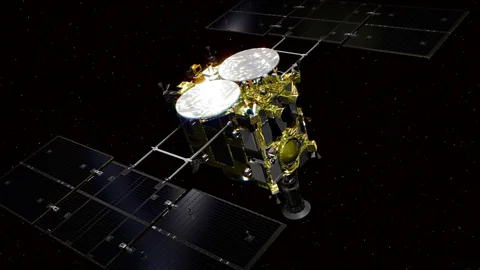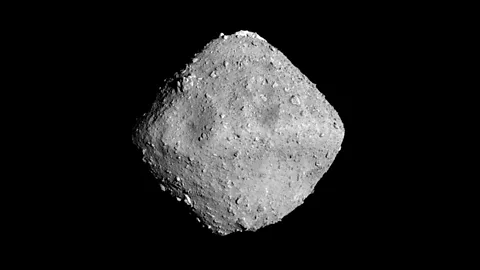A 'samurai' swordsmith is designing a space probe
 Getty Images
Getty ImagesThe ‘tamahagane’ steel used in traditional weapons may be the perfect material to cut through asteroids.
If you wanted to slice stuff up in space, what would you bring with you? 'Samurai' swords, which have been made in Japan for centuries, might be on your list because the tempered steel used in them is notoriously tough. There are plenty of videos online showing these Japanese swords, also called 'katana', cutting up everything from thick boards of wood to metal pipes.
Now, a trio of engineers have teamed up with a master Japanese swordsmith to design a rock-sampling device made with the same steel used in these blades – and the plan is to use it on an asteroid.
Japan’s Hayabusa missions have so far sent spacecraft, rovers and sampling tools to a one kilometre-wide asteroid called Ryugu, which orbits the sun between Earth and Mars. Hayabusa2’s rovers recently sent back stunning images of the asteroid’s black, rocky surface. But bringing fragments of Ryugu back to Earth is an enormously tricky task, which is why novel ideas are being suggested for how to do it.
If you like this, you may also enjoy:
In a paper detailing early experiments, the team – including Genrokuro Matsunaga, a 70-year-old swordsmith and Takeo Watanabe at Kanagawa Institute of Technology – explain how they have made several rock corers with various metallic compositions. Four contain tamahagane, the traditional metal made from iron sand and charcoal that is used in Japanese swords. “To achieve the sharpness and plasticity demand of the corer tip, we borrowed the techniques of traditional Japanese sword-smithing in fabricating the corer samples,” the authors write. (You can view stunning images of this process in our gallery: The amazing craft of samurai swords.)
 Go Miyazaki/Wikimedia Commons
Go Miyazaki/Wikimedia CommonsMatsunaga used iron sand from a beach in Japan, melted it down and tempered it to make the tamahagane. The process involved heating the metal to searing temperatures and then cooling it rapidly, over and over again.
The resulting corers are small, cylindrical devices with a bladed edge angled inwards. Instead of swiping a katana sword at the asteroid – which would be cool but impractical – the idea is to launch the tamahagane-tipped corer at the space rock at great speed. In theory, it will dig into the asteroid and allow for a sample to be scooped up.
Japan's untold stories
Welcome to BBC Future Now's Japan season, in which we explore the country's most exciting medical, technological, environmental and social trends.
Coming up, you can read:
Why 'flammable ice' may solve an energy crisis
The Olympic medals made from recycled phones
How Japan made fatherhood sexy
The secrets of Okinawa's superagers
... and many more.
Back in 2005, an earlier Hayabusa mission showed how difficult it was to grab significant quantities of rock from an asteroid. Two attempts to sample Ryugu were not triggered properly, though a small amount of dust was collected in a canister. One and a half thousand grains were later returned to Earth, but ideally an asteroid-sampler could gather up a lot more than that – and go deeper than just the surface rock.
This is because the surface of an asteroid is “weathered” over millions of years by cosmic rays, ultraviolet light and X-rays from the sun.
“Clearly it would tell us more about solar system history if we could get a sample from deeper into the rock to look at the unexposed pristine rock,” explains Martin Elvis at the Harvard-Smithsonian Center for Astrophysics.
But even getting surface or near-surface samples is difficult because of a basic property of asteroids: they’re small and don’t have much of a gravitational pull. Every time a rover or collecting device connects with or pushes down against an asteroid, it can easily bounce back off it again.
“Anything that allows you to use less force to cut into the asteroid surface – like this tamahagane steel – has to help,” says Elvis.
You might think of asteroids as solid boulders zooming through space, but often they are more like “rubble piles” of clustered rock that can be extremely unstable. Try slicing into that in near-zero gravity.
Indeed, we’ve very rarely got close to asteroids, let alone analysed what they’re made of directly, so one can never be quite sure of what we’ll find when we show up, says independent geophysicist and disaster researcher Mika McKinnon.
“You can even have ice mixed in and then as it heats up you can have an explosion as it turns to gas,” she says.
 JAXA/University of Tokyo
JAXA/University of TokyoSo far, the Japanese team have tested some of their corers by dropping them down a long pipe towards a concrete slab at the bottom of a tall stairwell. The samplers successfully extracted some concrete, but occasionally dropped it when being retrieved.
“A mechanism to prevent samples from falling off during the extraction and recovery phase needs to be devised,” the authors note.
Plus, the tamahagane corers themselves were not tested – because they were so expensive.
Still, these are the first steps towards blasting a sword-inspired sampling technology into space.
Is such a metal really the best material for the job? McKinnon is unsure, but she does point out that the emotional appeal of such a culturally significant metal is not to be ignored.
“By sending human elements with our spacecraft, we create ties to these machines that have gone on our behalf,” she says.
Perhaps that is the real value of tamahagane – it forges a very human link between us down here on Earth, and the asteroid the steel may one day sample. A samurai-inspired emissary whizzing through the solar system would connect Japan’s history and its future.
If you liked this story, sign up for the weekly bbc.com features newsletter, called “If You Only Read 6 Things This Week”. A handpicked selection of stories from BBC Future, Culture, Capital, and Travel, delivered to your inbox every Friday.

